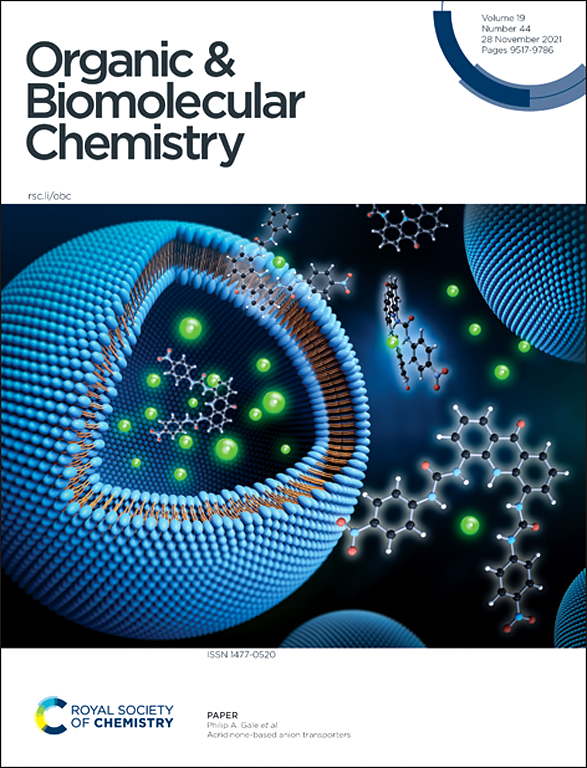同苯丙氨酸衍生苯并[1,4]二氮卓-2,5-二酮是强细菌群体感应抑制剂。
IF 2.9
3区 化学
Q1 CHEMISTRY, ORGANIC
引用次数: 0
摘要
苯并[1,4]二氮卓类药物具有多种生物活性,目前仍被广泛用作治疗多种疾病的药物。在化学酶促生物碱合成领域的研究中,我们开发了一种结构接近的合成路线,即苯并[1,4]二氮平-2,5-二酮。这些物质可能的抗菌活性几乎不为人所知。因此,我们筛选了其中的21种化合物,并发现了它们干扰细菌通讯的能力(群体感应,QS)。通过精制的合成路线衍生出相应物质的衍生产物,产生了9代具有显著增强活性的同源物,为苯并[1,4]二氮卓-2,5-二酮(一种以前未被研究的化合物类别)作为QS调节剂的应用奠定了基础。通过分子对接实验对参与QS的潜在蛋白相互作用伙伴LuxP、LasR、AbaI和RhlR进行了评价。对接计算结果表明,在激光共振的自诱导结合口袋中,3个类似物5q、15a和15b存在一个高能结合位点,而氟取代基在二氮杂类核心结构上的位置决定了化合物的确切空间取向。本文章由计算机程序翻译,如有差异,请以英文原文为准。
![Homophenylalanine-derived benzo[1,4]diazepine-2,5-diones are strong bacterial quorum sensing inhibitors†](https://img.booksci.cn/booksciimg/2024-11/99296424981767756145.jpg)
Homophenylalanine-derived benzo[1,4]diazepine-2,5-diones are strong bacterial quorum sensing inhibitors†
Benzo[1,4]diazepines show a large diversity of biological activities and are still commonly used as medications against a broad range of diseases. Within our research in the field of chemo-enzymatic alkaloid synthesis, we developed a synthetic route towards close structural relatives, namely benzo[1,4]diazepine-2,5-diones. Possible antimicrobial activities of these substances are barely known up to date. We thus screened a selection of 21 of these compounds and discovered their ability to interfere with bacterial communication (quorum sensing, QS). Derivatisation of the respective substances by a refined synthetic route resulted in a generation of 9 congeners with drastically enhanced activity, setting the stage for the application of benzo[1,4]diazepine-2,5-diones, a formerly under-investigated compound class, as QS modulators. Molecular docking experiments were performed to evaluate potential protein interaction partners – LuxP, LasR, AbaI, and RhlR – which are involved in QS. The results of the docking calculations show a high energy binding site for three analogues, , and , in the autoinducer binding-pocket of LasR, with the position of a fluorine substituent on the diazepine core structure determining the exact spatial orientation of the compounds.
求助全文
通过发布文献求助,成功后即可免费获取论文全文。
去求助
来源期刊

Organic & Biomolecular Chemistry
化学-有机化学
CiteScore
5.50
自引率
9.40%
发文量
1056
审稿时长
1.3 months
期刊介绍:
Organic & Biomolecular Chemistry is an international journal using integrated research in chemistry-organic chemistry. Founded in 2003 by the Royal Society of Chemistry, the journal is published in Semimonthly issues and has been indexed by SCIE, a leading international database. The journal focuses on the key research and cutting-edge progress in the field of chemistry-organic chemistry, publishes and reports the research results in this field in a timely manner, and is committed to becoming a window and platform for rapid academic exchanges among peers in this field. The journal's impact factor in 2023 is 2.9, and its CiteScore is 5.5.
 求助内容:
求助内容: 应助结果提醒方式:
应助结果提醒方式:


